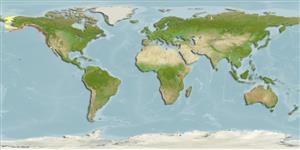Common names from other countries
Environment: milieu / climate zone / depth range / distribution range
Ecología
; rango de profundidad 0 - 60 m (Ref. 95344). Subtropical
Distribución
Países | Áreas FAO | Ecosistemas | Ocurrencias, apariciones | Introducciones
Eastern Pacific and the Arctic: Alaska to California. Subtropical to boreal.
Length at first maturity / Tamaño / Peso / Age
Maturity: Lm ? range ? - ? cm Max length : 9.0 cm SHL macho / no sexado; (Ref. 865); common length : 8.0 cm SHL macho / no sexado; (Ref. 312)
Description: Shell has spiral ridges. Has at least three prominent wing-like structures, worn off in older snails. Color is brown and white to creamy-white. Young snails have tooth-like projections on the lip of the shell (Ref. 312).
Occurs in the low intertidal zone. Uses the radula to bore through the calcareous shells of its prey (clams, mussels, and barnacles; Ref. 312) (Ref. 312).
Life cycle and mating behavior
Madurez | Reproducción | Puesta | Huevos | Fecundidad | Larva
This species is a non-broadcast spawner. Life cycle does not include trocophore stage. Also Ref. 833.
Gallivan, G. and J. Danforth. 1999. (Ref. 312)
IUCN Red List Status (Ref. 130435)
CITES status (Ref. 108899)
Not Evaluated
Not Evaluated
Human uses
| FishSource |
Herramientas
Más información
Age/SizeCrecimientoLength-weightLength-lengthMorfologíaLarvaAbundancia
Fuentes de Internet
Estimates based on models
Preferred temperature
(Ref.
115969): 5.7 - 12, mean 8.9 (based on 132 cells).
Price category
Unknown.
